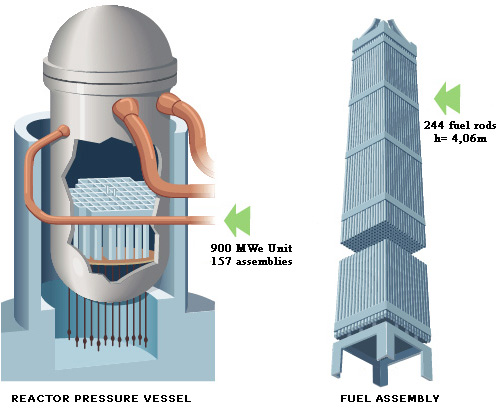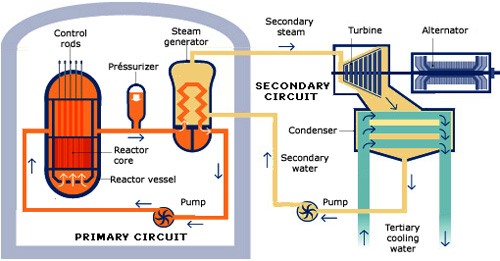High pressure water to evacuate heat and slow down neutrons
The reactor core is the source of energy. Similar to the hearth of a boiler, it produces heat. It consists of fuel elements containing pellets of uranium enriched to 3.5% or including also plutonium (MOX). A metallic rod of “Zircaloy surrounds these elements. This first barrier traps the radioactive products that that are formed within the pellets.

Reactor core and fuel assemblies
Chain reactions that produce energy take place in the fuel assemblies. The high pressure (150 atmospheres) water flows between the fuel assemblies in order to remove heat from fission reactions. It also slow down the neutrons so that they can maintain the chain reaction. The core of a reactor producing 0.9 Gigawatts of electric power contains 157 fuel assemblies, 41,448 rods and 11,273,856 oxide pellets of enriched uranium.
© Source AREVA
The core is contained within the reactor pressure vessel, a sealed metal vessel, coated in the inside with stainless steel. It includes control devices, mainly neutrons absorbing cadmium rods, as well as safety devices. This vessel is a second containment barrier.
Water circulates inside the high pressure vessel between the fuel elements. It removes the heat generated in the fuel elements and also plays the role of moderator. The pressure of the primary water reaches 155 atmospheres.

PWR Operation principle
The fuel rods containing uranium make the core of a pressurized water reactor (PWR). Water is heated in contact with fuel rods to a high temperature in a closed primary circuit, the reactor vessel. This water vaporizes the water of a secondary circuit through heat exchangers called steam generators. The secondary steam drives a turbine that drives an alternator that produces electricity. The steam leaving the turbine is cooled and condensed into water before returning to the steam generator. The condenser itself is cooled by the water of a third circuit. Pumps circulate water in these circuits. A pressurizer maintains the primary circuit water under high pressure and prevents it from boiling. Control rods allow to control the chain reaction.
© Source AREVA
The temperature of the primary water leaving the reactor core is about 300 °C. This water then passes through a heat exchanger, called “steam generator”, where it cools by vaporizing the water of a secondary circuit. In the steam generator, secondary water cools the tubes where the primary water circulates before returning to the reactor vessel. At the exit of the steam generator, the secondary water steam pressure is 70 atmospheres.
The secondary circuit is a closed circuit. The steam is sent through a turbine. The turbine drives an alternator that is coupled. The alternator produces electricity to be sent to the national grid at high voltage. The secondary steam is condensed at the outlet of the turbine, before being recycled into the steam generators.
The reactor core, the primary circuit and steam generators are housed in a containment building sealed by a single or double concrete wall. This building is about 50 m in diameter and 60 m in height. It is depressurized to prevent leaks to the outside. This containment provides a third protective barrier.
The steam exiting the turbine outlet is condensed by a high flow of water circulating at high rate in a third cooling circuit. The condensed steam then returns to the generators. “Tertiary” water, which itself needs to be cooled, is sent to large cooling towers (one per reactor). These towers are the most visible part of a nuclear plant. They give off plumes of water vapour.
To compensate the water lost by evaporation in towers, external water is needed. Nuclear power plants are located near the sea or rivers, whose water is not in contact with radioactive materials because of the various containment barriers.

Cooling towers
Cooling towers of the Golfech nuclear power plant on the banks of the Garonne river in France. Visibles at great distances, these cooling towers are the most visible part of nuclear power plants.
© EDF – Didier Marc
In the event of a heat waves with a decrease in the water level, nuclear power plants located at the seaside to produce electricity are favored. Power plants located along rivers are equipped with cooling towers using the atmosphere as the cold source.
In total, in France, 98% of the quantity of water used for the nuclear production of electricity returns to the environment without degradation of its quality and radioactive contamination.
Other articles on the subject « Nuclear Reactors »
Reactor Families
A variety of designs : Natural uranium or enriched uranium as fuel There are several industrial t[...]
World nuclear reactors
A development that takes place today in Asia At the beginning of 2014 the number of reactors in o[...]
Generation I reactors
1950-1970: First generation of reactors (50 – 500 MWe) The first generation reactors were i[...]
RBMK reactors
Soviet-era reactors at Chernobyl Cold War and the Iron Curtain led after 1947 to the development [...]
Generation II Reactors
1970-2009: the rise of nuclear energy About 85% of electricity produced worldwide by nuclear powe[...]
PWR Reactors
The most widespread type of reactor … Pressurised water reactors (PWR) are by far the most [...]
Boiling Water Reactors
BWR or Boiling Water Reactors Boiling water reactors or BWR are in operation in the United States[...]
Candu reactors
Canadian reactors using natural uranium and heavy water CANDU is a nuclear reactor brand develope[...]
Nuclear Propulsion
On-board reactors for submarines and aircraft carriers In addition to conventional land-based pow[...]